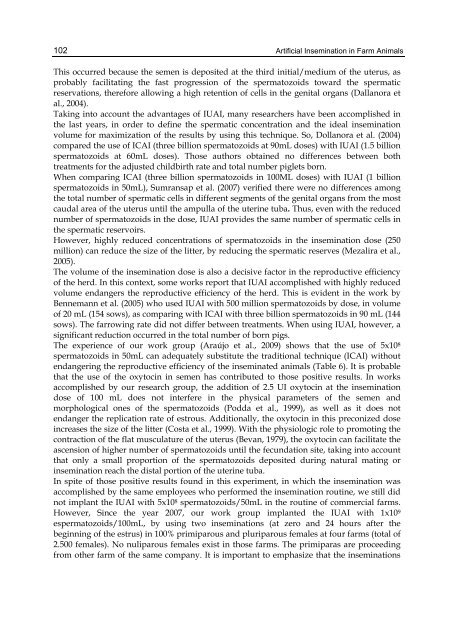ARTIFICIAL INSEMINATION IN FARM ANIMALS - Phenix-Vet
ARTIFICIAL INSEMINATION IN FARM ANIMALS - Phenix-Vet
ARTIFICIAL INSEMINATION IN FARM ANIMALS - Phenix-Vet
Create successful ePaper yourself
Turn your PDF publications into a flip-book with our unique Google optimized e-Paper software.
102Artificial Insemination in Farm AnimalsThis occurred because the semen is deposited at the third initial/medium of the uterus, asprobably facilitating the fast progression of the spermatozoids toward the spermaticreservations, therefore allowing a high retention of cells in the genital organs (Dallanora etal., 2004).Taking into account the advantages of IUAI, many researchers have been accomplished inthe last years, in order to define the spermatic concentration and the ideal inseminationvolume for maximization of the results by using this technique. So, Dollanora et al. (2004)compared the use of ICAI (three billion spermatozoids at 90mL doses) with IUAI (1.5 billionspermatozoids at 60mL doses). Those authors obtained no differences between bothtreatments for the adjusted childbirth rate and total number piglets born.When comparing ICAI (three billion spermatozoids in 100ML doses) with IUAI (1 billionspermatozoids in 50mL), Sumransap et al. (2007) verified there were no differences amongthe total number of spermatic cells in different segments of the genital organs from the mostcaudal area of the uterus until the ampulla of the uterine tuba. Thus, even with the reducednumber of spermatozoids in the dose, IUAI provides the same number of spermatic cells inthe spermatic reservoirs.However, highly reduced concentrations of spermatozoids in the insemination dose (250million) can reduce the size of the litter, by reducing the spermatic reserves (Mezalira et al.,2005).The volume of the insemination dose is also a decisive factor in the reproductive efficiencyof the herd. In this context, some works report that IUAI accomplished with highly reducedvolume endangers the reproductive efficiency of the herd. This is evident in the work byBennemann et al. (2005) who used IUAI with 500 million spermatozoids by dose, in volumeof 20 mL (154 sows), as comparing with ICAI with three billion spermatozoids in 90 mL (144sows). The farrowing rate did not differ between treatments. When using IUAI, however, asignificant reduction occurred in the total number of born pigs.The experience of our work group (Araújo et al., 2009) shows that the use of 5x10 8spermatozoids in 50mL can adequately substitute the traditional technique (ICAI) withoutendangering the reproductive efficiency of the inseminated animals (Table 6). It is probablethat the use of the oxytocin in semen has contributed to those positive results. In worksaccomplished by our research group, the addition of 2.5 UI oxytocin at the inseminationdose of 100 mL does not interfere in the physical parameters of the semen andmorphological ones of the spermatozoids (Podda et al., 1999), as well as it does notendanger the replication rate of estrous. Additionally, the oxytocin in this preconized doseincreases the size of the litter (Costa et al., 1999). With the physiologic role to promoting thecontraction of the flat musculature of the uterus (Bevan, 1979), the oxytocin can facilitate theascension of higher number of spermatozoids until the fecundation site, taking into accountthat only a small proportion of the spermatozoids deposited during natural mating orinsemination reach the distal portion of the uterine tuba.In spite of those positive results found in this experiment, in which the insemination wasaccomplished by the same employees who performed the insemination routine, we still didnot implant the IUAI with 5x10 8 spermatozoids/50mL in the routine of commercial farms.However, Since the year 2007, our work group implanted the IUAI with 1x10 9espermatozoids/100mL, by using two inseminations (at zero and 24 hours after thebeginning of the estrus) in 100% primiparous and pluriparous females at four farms (total of2.500 females). No nuliparous females exist in those farms. The primiparas are proceedingfrom other farm of the same company. It is important to emphasize that the inseminations










